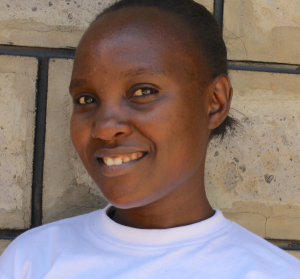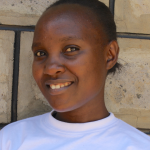June, 2020: COVID-19 Prevention Training Update at Sichinji Community, Makhatse Spring
Our teams are working on the frontlines of the COVID-19 pandemic. Join us in our fight against the virus while maintaining access to clean, reliable water.

Trainer Rose demonstrates handwashing
We are carrying out awareness and prevention trainings on the virus in every community we serve. Very often, our teams are the first (and only) to bring news and information of the virus to rural communities like Sichinji, Kenya.
We trained more than 32 people on the symptoms, transmission routes, and prevention of COVID-19. Due to public gathering concerns, before there were any cases in the area we worked with trusted community leaders to gather a select group of community members who would then relay the information learned to the rest of their family and friends.

Trainer Janet demonstrates handwashing
We covered essential hygiene lessons:
- Demonstrations on how to build a simple handwashing station
- Proper handwashing technique
- The importance of using soap and clean water for handwashing
- Cleaning and disinfecting commonly touched surfaces including at the water point.

Sharing COVID-19 informational pamphlets
We covered COVID-19-specific guidance in line with national and international standards:
- Information on the symptoms and transmission routes of COVID-19
- What social distancing is and how to practice it
- How to cough into an elbow
- Alternative ways to greet people without handshakes, fist bumps, etc.
- How to make and properly wear a facemask.

Reading a pamphlet
During training, we installed a new handwashing station with soap near the community’s water point, along with a sign with reminders of what we covered.

Prevention remidners chart installed at the spring
Due to the rampant spread of misinformation about COVID-19, we also dedicated time to a question and answer session to help debunk rumors about the disease and provide extra information where needed.

Observing social distancing
We continue to stay in touch with this community as the pandemic progresses. We want to ensure their water point remains functional and their community stays informed about the virus.

Homemade mask tutorial
Water access, sanitation, and hygiene are at the crux of disease prevention. You can directly support our work on the frontlines of COVID-19 prevention in all of the communities we serve while maintaining their access to safe, clean, and reliable water.

June, 2019: Sichinji Community, Makhatse Spring Project Complete
Sichinji Community is celebrating its new protected spring, so celebrate with them! Makhatse Spring has been transformed into a flowing, safe source of water thanks to your donation. The spring is protected from contamination, five sanitation platforms have been provided for the community, and training has been done on sanitation and hygiene.
Spring Protection
Construction at Makhatse Spring was successful and water is now flowing from the discharge pipe.
"I'm really grateful to you for considering our spring for protection," said Mrs. Indeche.
"Accessibility was a big issue, especially during the rainy seasons when we would wade through knee-deep mud to access water. At least now I'll be clean and I can also send my children to the spring because the risk of slipping has been eliminated."

The Process:
Construction went on well without challenges since the community members were cooperative in providing local sand and stones for the artisan to use, and were always there to help with manual labor.

Children help by carrying bricks to the construction site on their day off from school.
The spring area was excavated with jembes, hoes, and spades to create space for setting the foundation of polyethylene, wire mesh, and concrete. This step of the process yielded a surprise: the artisan found old cement under all of the dirt. Upon inquiring around the community, he found out that there was a spring protection from 1911!

Cement, waterproof coating, ballast, and sand were mixed together to make a very strong foundation.

Brickwork started with the artisan taking all of the required measurements of the spring structure before proceeding with the work. Construction of the superstructure continued with discharge pipes fixed in the brick wall.

Stairs were built on both sides of the spring to allow in and out movement by users.
Stone pitching along the lower part of the spring was done to prevent soil from eroding and blocking the outlet drainage. Finally, the plastering of the walls and the floor was done, and tiles were placed below the discharge pipes to keep the falling water from hitting the cement.
The spring was then left for two days to undergo curing and hardening before being backfilled using stones.
Polythene was stretched across the top and covered with soil to allow clean water to flow from the pipe. Community members promised to dig cut-off drainage at the slope of the spring to divert surface water from entering the spring and to also plant grass over the protected area to prevent erosion.
Sanitation Platforms
All five sanitation platforms have been installed and make wonderful, easy to clean latrine floors. These five families are happy about this milestone of having a latrine of their own. We will continue to encourage them to finish building walls and roofs over their new latrine floors as we visit for monitoring and evaluation.

New Knowledge
The community health volunteers and water, sanitation, and management committee training at Makhatse Spring was one of a kind. The participants came out in large numbers and sat patiently and listened attentively. The facilitator was able to talk to the participants in their local dialect and this made them very happy. They felt at home and did not see the hygiene training as something strange but just common knowledge and practices which any local Kenyan can adopt.
After the training, we could see that they had embraced the project more and had a sense of ownership. Despite the training ending at 5pm, when most of the women would have left to prepare supper for their families, they instead went downstream to a nearby river to collect sand for the completion of the spring protection construction. We commended them on their commitment to the project and we are hopeful that the community will improve on their hygiene standards.

Participants learned about topics including:
– Environmental hygiene
– Waterborne and water-related disease, along with water treatment methods and how to properly handle water

One of the participants had brought water in a 20-liter jerrycan for our demonstrations on dental hygiene and handwashing. When the facilitator looked at the jerrycan, it was evident that it is never cleaned, nor did it have a lid.
The facilitator seized the opportunity to tackle the topic of water handling and treatment. She demonstrated how women usually dip their fingers in a jerrycan as they lift it onto their heads. When she put the jerrycan on her lap, a big smudge of mud was seen on her skirt. This was a further indication that the jerrycan was dirty. The women promised to clean their water containers and ensure that all of them have lids.
– Leadership and governance for the spring committee
– Management and maintenance of the spring

Training participants gathered around their spring as it's under construction
Community members were taken over to the protected spring to talk about how it works, how to care for it, and rules that should be set for spring use. People should not be doing laundry near the spring nor should bring their animals to the location.
– Family planning
– Personal hygiene, highlighting handwashing and dental hygiene

During demonstration on handwashing, the facilitator demonstrated the way that most people in the villages wash their hands: He did this by sparingly sprinkling water from a jug on his fingertips. The participants were very amused and requested the facilitator to repeat what he had just done. They confirmed that he was right.
The facilitator then proceeded to show community members the way handwashing should be done. Some of them found the ten steps of handwashing to be very tedious, especially for large families during meal times. However, the trainer emphasized the importance of thorough handwashing with running water and soap and its role in preventing illnesses. He also encouraged them to improvise leaky tins (handwashing stations) instead of depending on a jug that they have to pick up and pour.
Thank You for making all of this possible.


 Protected Spring
Protected Spring
 Rehabilitation Project
Rehabilitation Project









































